American film star Buck Jones (1891–1942) starred in many popular B-Westerns of the 1920s, 1930s, and 1940s. Executive William Fox decided to use him as a backup to Tom Mix. This led to his first starring role, The Last Straw (Denison Clift, Charles Swickard, 1920). With his famed horse Silver, Jones would make more than 160 films.

German postcard by Ross Verlag, no. 1339/1, 1927-1928. Photo: Albert Witzel / Fox.

German postcard by Ross Verlag, no. 3196/1, 1928-1929. Photo: Fox.
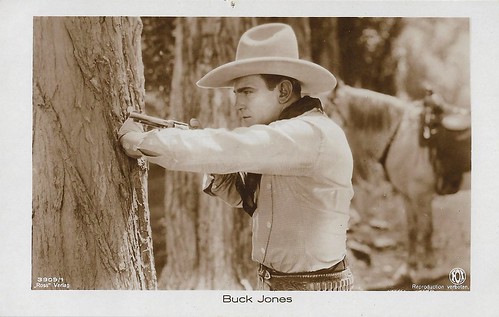
German postcard by Ross Verlag, no. 3909/1, 1928-1929. Photo: Fox.
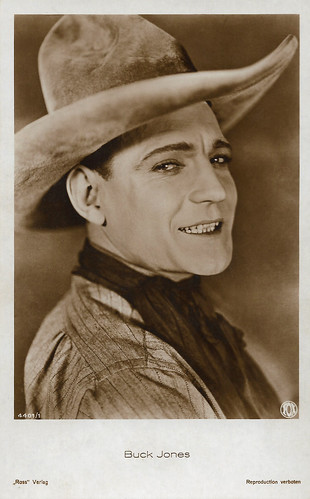
German postcard by Ross Verlag, no. 4401/1, 1929-1930. Photo: Fox.
Buck Jones was born Charles Frederick Gebhart in 1891 in Vincennes, Indiana, USA.
Jones reportedly (but disputably) grew up on a ranch near Red Rock in Indian Territory (now Oklahoma), and there learned the riding and shooting skills that would stand him in good stead as a hero of Westerns.
He joined the army as a teenager and served on the US-Mexican border before seeing service in the Moro uprising in the Philippines. Though wounded, he recuperated and re-enlisted, hoping to become a pilot.
He was not accepted for pilot training and left the army in 1913. He took a menial job with the Miller Brothers 101 Ranch Wild West Show and soon became champion bronco buster for the show. He moved on to the Julia Allen Show, but with the beginning of the First World War, Jones took work training horses for the Allied armies.
After the war, he and his wife, Odelle Osborne, whom he had met in the Miller Brothers show, toured with the Ringling Brothers circus. While in Los Angeles with the circus, Jones decided to leave the cowboy life behind and get a job in the film industry.

American postcard. Photo: Fox. Buck Jones in Pardon My Nerve! (B. Reeves Eason, 1922).
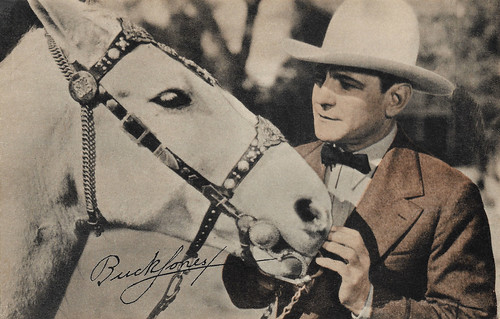
British postcard in the A Real Photogravure Portrait series.
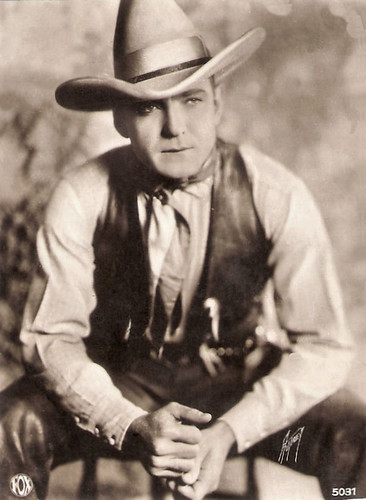
French postcard, no. 5031. Photo: Max Munn Autrey / Fox.

French postcard by A.N., Paris, no. 186. Photo: Fox Film.
Buck Jones was hired by Universal Pictures for $5 per day as a bit player and stuntman. In his early film appearances, he was billed as Charles Jones. He later worked for Fox as a stuntman. He joined Hoot Gibson, Tom Mix, and Ken Maynard as the top cowboy actors of the 1920s. According to Jim Beaver at IMDb, he played "a more dignified, less gaudy hero than Mix, if not as austere as William S. Hart."
When sound film was introduced, the major studios weren't interested anymore in Jones. He signed with then-humble Columbia Pictures, starring in Westerns like The Lone Rider (Louis King, 1930) for $300 a week, a fraction of his top salary in the silent-film days.
His voice, a rugged baritone, recorded well and the films were very successful, re-establishing him as a major movie name. During the 1930s he starred in Western features and serials for Columbia and Universal Pictures.
His star waned in the late 1930s when singing cowboys became the rage and Jones, then in his late forties, was uncomfortably cast in conventional leading-man roles. He re-joined Columbia in the fall of 1940, starring in the serial White Eagle. The new serial was a hit, and Jones was again re-established.
His final series of Western features, co-produced by Jones and his friend Scott R. Dunlap of Monogram Pictures, featured The Rough Riders trio: Buck Jones, Tim McCoy, and Raymond Hatton. Buck Jones was one of the 492 victims of the 1942 Cocoanut Grove fire in Boston. Jones was horribly burned and died two days later.
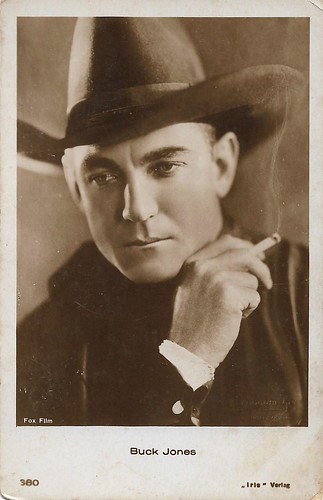
Austrian postcard by Iris Verlag, no. 380. Photo: Fox Film.
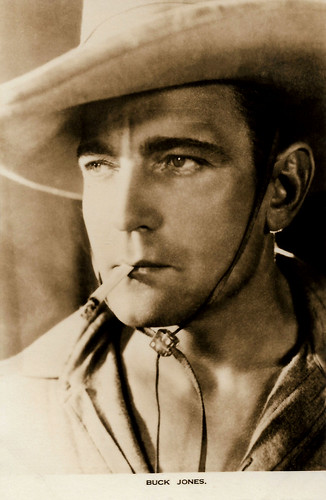
British postcard by Film Weekly, London.
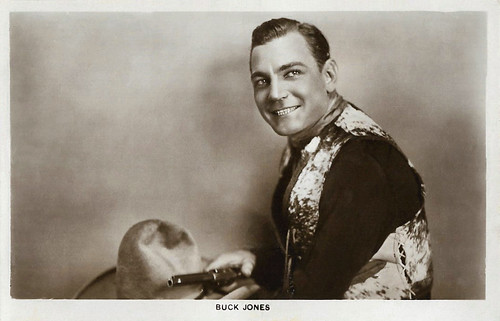
British postcard in the Picturegoer Series, London, no. 146a. Photo: Albert Witzel, Hollywood.

British postcard. Photo: Buck Jones in White Eagle (Lambert Hillyer, 1932).
Source: Jim Beaver (IMDb), Wikipedia and IMDb.
This post was last updated on 26 November 2024.

German postcard by Ross Verlag, no. 1339/1, 1927-1928. Photo: Albert Witzel / Fox.

German postcard by Ross Verlag, no. 3196/1, 1928-1929. Photo: Fox.

German postcard by Ross Verlag, no. 3909/1, 1928-1929. Photo: Fox.

German postcard by Ross Verlag, no. 4401/1, 1929-1930. Photo: Fox.
Champion Bronco Buster
Buck Jones was born Charles Frederick Gebhart in 1891 in Vincennes, Indiana, USA.
Jones reportedly (but disputably) grew up on a ranch near Red Rock in Indian Territory (now Oklahoma), and there learned the riding and shooting skills that would stand him in good stead as a hero of Westerns.
He joined the army as a teenager and served on the US-Mexican border before seeing service in the Moro uprising in the Philippines. Though wounded, he recuperated and re-enlisted, hoping to become a pilot.
He was not accepted for pilot training and left the army in 1913. He took a menial job with the Miller Brothers 101 Ranch Wild West Show and soon became champion bronco buster for the show. He moved on to the Julia Allen Show, but with the beginning of the First World War, Jones took work training horses for the Allied armies.
After the war, he and his wife, Odelle Osborne, whom he had met in the Miller Brothers show, toured with the Ringling Brothers circus. While in Los Angeles with the circus, Jones decided to leave the cowboy life behind and get a job in the film industry.

American postcard. Photo: Fox. Buck Jones in Pardon My Nerve! (B. Reeves Eason, 1922).

British postcard in the A Real Photogravure Portrait series.

French postcard, no. 5031. Photo: Max Munn Autrey / Fox.

French postcard by A.N., Paris, no. 186. Photo: Fox Film.
The Rough Riders
Buck Jones was hired by Universal Pictures for $5 per day as a bit player and stuntman. In his early film appearances, he was billed as Charles Jones. He later worked for Fox as a stuntman. He joined Hoot Gibson, Tom Mix, and Ken Maynard as the top cowboy actors of the 1920s. According to Jim Beaver at IMDb, he played "a more dignified, less gaudy hero than Mix, if not as austere as William S. Hart."
When sound film was introduced, the major studios weren't interested anymore in Jones. He signed with then-humble Columbia Pictures, starring in Westerns like The Lone Rider (Louis King, 1930) for $300 a week, a fraction of his top salary in the silent-film days.
His voice, a rugged baritone, recorded well and the films were very successful, re-establishing him as a major movie name. During the 1930s he starred in Western features and serials for Columbia and Universal Pictures.
His star waned in the late 1930s when singing cowboys became the rage and Jones, then in his late forties, was uncomfortably cast in conventional leading-man roles. He re-joined Columbia in the fall of 1940, starring in the serial White Eagle. The new serial was a hit, and Jones was again re-established.
His final series of Western features, co-produced by Jones and his friend Scott R. Dunlap of Monogram Pictures, featured The Rough Riders trio: Buck Jones, Tim McCoy, and Raymond Hatton. Buck Jones was one of the 492 victims of the 1942 Cocoanut Grove fire in Boston. Jones was horribly burned and died two days later.

Austrian postcard by Iris Verlag, no. 380. Photo: Fox Film.

British postcard by Film Weekly, London.

British postcard in the Picturegoer Series, London, no. 146a. Photo: Albert Witzel, Hollywood.

British postcard. Photo: Buck Jones in White Eagle (Lambert Hillyer, 1932).
Source: Jim Beaver (IMDb), Wikipedia and IMDb.
This post was last updated on 26 November 2024.
No comments:
Post a Comment